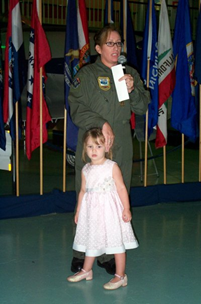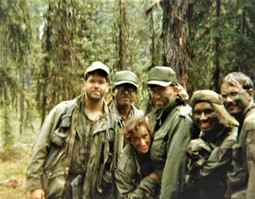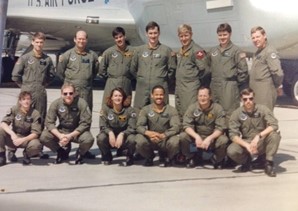Pardon my language, but my mom is a badass. In 1987, my mom, Beth Yandow, was one of the first women to fly combat missions in the U.S. Air Force. Within a few years, she became the first female Airborne Mission Supervisor on the RC-135 Rivet Joint Reconnaissance Aircraft. This was a major breakthrough for women’s rights in the Air Force, as previously only men were allowed in combat roles. Unfortunately, this change defying gendered barriers at the foundation of the patriarchal American military was, and still is, a real challenge.

How did women advance and come to lead in new areas of the male-dominated military? By interviewing both female and male Air Force Veterans in the late 1980’s and early 1990s, I found that these women assimilated in the masculine world of the military to rise up the ranks.
“One of the boys”
A female airman described the military as a “man’s world,” where numerous taboos and stigmas encourage and incentivize men to exclude women. The most common arguments against women serving in combat roles was that they would distract the men and interfere with the unit’s camaraderie. As one female veteran told me, they might “break up the boys club.”
Women understood that to survive, let alone be competitive, they must fit in and assimilate within the patriarchy itself. They had to become “one of the boys.” What better way to fit in with men, than to act like one (Duncanson 2016)?

To be “one of the boys” or one of the “cool women,” female airmen distanced themselves from their femininity. They instead developed and displayed masculine characteristics in hopes of earning the respect and recognition of their peers. Some women engaged in common male behaviors such as swearing, telling dirty jokes, chewing tobacco and smoking. One woman went so far as to speak tonelessly and with a deep voice.

Not only did becoming “one of the boys” help women integrate and bond with the men in their unit, but it helped earn their respect. For example, when my mom was in survival school, her squad was tasked with caring for a “cute bunny” until they were told someone had to kill the rabbit and prepare it for a meal. As the only woman in her unit, my mom was elected to do the honor. To everyone’s surprise she did it with zero hesitation. This left her team completely flabbergasted by her bold “unladylike” actions. Although the situation required an unconventional snack for my mom, it resulted in her earning respect and acceptance from the men.

A debate surrounds whether this strategy truly benefits women and their positions within the military. Some scholars herald the opening of positions in the military thanks to my mom and women like her (Culler 2000). While others propose that the military may never be compatible with gender equality (Decew 1995). These works emphasize women’s mimicry of masculinity as merely producing partial inclusion and unintentionally reinforcing the military’s patriarchy by supporting and reproducing masculine norms (Kanter 1977).
In speaking with some of the first women in Air Force combat positions, they expressed how their conformity to masculine norms was rooted in efforts for career advancement, and ultimately, maintaining their jobs. These female pioneers felt their success in “breaking glass ceilings” mattered not only for themselves but for future female airmen. Despite the heroic efforts of women breaking new ground across parts of the military, it remains far from achieving gender equality. Women still face workplace discrimination and are rarely selected for higher-level jobs especially leadership positions (Orchard 2019). It took 10 years for the second female to become an Airborne Mission Supervisor after my mom. 10 years! Women are still obstructed by the masculine norms within the military, the beliefs of male airmen and leadership, and sometimes the female airmen themselves. As a current ROTC cadet, it is apparent that even after all these years, I face and challenge the same barriers as my mom.
Sources:
Culler, K. (n.d.). Decision to allow military women into combat positions: A study in policy and politics. Naval Postgraduate School.
Decew, J. W. (1995). The combat exclusion and the role of women in the military. Hypatia, 10(1), 56-73. doi:10.1111/j.1527-2001.1995.tb01353.x
Duncanson, C., & Woodward, R. (2015). Regendering the military: Theorizing women’s military participation. Security Dialogue, 47(1), 3-21. doi:10.1177/0967010615614137
Kanter, R. M. (1977). Some effects of proportions on group life. The Gender Gap in Psychotherapy, 53-78. doi:10.1007/978-1-4684-4754-5_5
Orchard, B. (2019). A briefing on the un women female military officers’ course. Journal of Peacebuilding & Development, 15(1), 117-121. doi:10.1177/1542316619866421